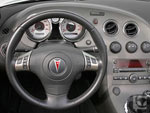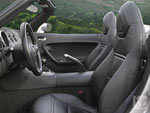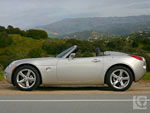 It took the better part of a decade, a couple hundred million bucks, and probably a few bags full of smashed bureaucratic skulls, but here it is: a modern, self-made, low-priced, freshly-engineered, rear-wheel-drive sports car from General Motors. This would normally be cue to whip out your calculator to keep track of the contradictions and impossibilities in that statement, but it's true: working under the same roof as the guys who have been hired to glue Saab badges onto Chevrolet TrailBlazers exists at least a few who actually care about cars.
It took the better part of a decade, a couple hundred million bucks, and probably a few bags full of smashed bureaucratic skulls, but here it is: a modern, self-made, low-priced, freshly-engineered, rear-wheel-drive sports car from General Motors. This would normally be cue to whip out your calculator to keep track of the contradictions and impossibilities in that statement, but it's true: working under the same roof as the guys who have been hired to glue Saab badges onto Chevrolet TrailBlazers exists at least a few who actually care about cars.Starting life as some sort of automotive Frankenstein put together from an amalgam of parts from a Cavalier, Pontiac Grand Am, Subaru Impreza, etc., the original Solstice was a somewhat confused concept, but its killer looks gave it enough magnetism to justify production. Luckily, only the looks carried through the years - incredibly faithfully, by production car standards - while the interim provided time to create the "Kappa" platform it rides on, replete with double-wishbone suspensions, the best version of GM's 4-cylinder Ecotec engine, and Corvette-like hydroformed construction. Best yet, the promise of a "less than $20,000" sticker came true.
No doubt, the Solstice is destined for low volumes and puny profits. And status as the most important car GM has created in decades.
Road Test

Pontiac had some thinking to do about what the Solstice should be, for it stands at a cultural crossroads. To go frisky and lithe like the British and Japanese entrants before it, or brutish and torquey like they've always done? That is the question.
This particular Pontiac got pointed somewhere down the middle. Its engine is equal in design to the best of them - aluminum block and head, twin camshafts, and variable timing on all 16 of its valves - but GM being GM, they made theirs bigger than anyone else's at 2.4 liters - a good 20% up on the Miata - with an undersquare (long stroke) design to further favor torque. With 166 pounds-feet, the Solstice ain't no GTO, but there's enough instant muscle to pass for a V6 Grand Prix and 177 horses to look forward to.
So while the Solstice can't burn rubber like some Pontiacs, it can carve through canyons faster than any before it. The 157.2-inch body makes it one of the smallest cars on the road while riding on some of the fattest tires, clocks in at 2,860 pounds (53% of them in front), and has a double-wishbone setup with Bilstein shocks at each corner to manage them. You can cut any corner and count on the rear end tracking through faithfully, bumps not upsetting your line and the body not leaning much at all. Pontiac also chose a traditional hydraulic steering rack, blessing the Solstice with optimal feedback and predictable reactions. Helping every maneuver is the fact that the power goes to the proper set of wheels: the rears. See how important it is to have the right ingredients?
The first six months of Solstii all get proper transmissions, too: a 5-speed stick (from the Chevy Colorado) with properly stiff detents and a clutch with a fairly aggressive return spring. In slow-speed city driving, the Solstice is a bit of work, with those factors calling for concentration plus all that noise piercing through the cloth top - much of it the thrash of your own engine.
Hit the highway and things improve. A big engine with tall transmission gearing gets the engine out of your ears and the ride is at least as civil as the Miata's, with some bumps hitting big but not hitting often. Tracking is precise and noise is manageable, with the only standout being the wind whistling behind your ears from the somewhat insecure softtop seals. The tall gearing makes itself known in certain cases - climb a mild mountain in 5th gear and watch the speedometer fall to 67 MPH - but all things considered, the Solstice is a viable cross-country cruiser. Meanwhile, its structure's hydroformed frame rails (in which big pieces are shaped via extreme water pressure instead of by spot-welding a bunch of little pieces together) are to thank for the stiff, shake-free body. (Most of those curvaceous body panels are hydroformed as well.)
For full Solstice satisfaction, find your own road - the harder, the better. This roadster races right through them simply by virtue of physics alone, its monstrous tires clawing the road and first-rate brakes ready to stop you on a dime. The shifter's annoyances vanish with speed, leaving only pleasure in the upper gears, and at the handling limit the Solstice has been set up to err on the side of understeer, losing traction gradually and never threatening to swap ends. In that respect, it's the dynamic opposite of big brother Corvette.
But one can only coast on the advantages of physics for so long before facing off against others with the same edge. Starting with the last point, yes, the wide-bodied Solstice always feels stern and planted and safety is indeed a good thing, but Mazda's Miata gets raves because it knows how to loosen up and have a good time. A little tail rotation never killed anyone. (Ok, technically it has, but it's still one of the joys expected in a rear-drive roadster.)
Even when far from the limit, there's a noticeable gap in the fun factor. The impressive paper specs common to both say nothing of the Mazda motor's far more interesting soundtrack or quicker-revving nature, and the Miata's shifter and clutch feel more precise while emitting none of the Pontiac's mysterious CLUNK and CRUNCH sounds. The Miata's steering also manages to feel more natural even while handicapped with the distinct disadvantage of being electric, and finally, the Solstice could have used a few more Slim-Fast sessions, as its extra 400 pounds explain its slight laziness in every maneuver. Cumulatively, these factors explain why it only netted 24 MPG vs. our Miata's 32 (both request premium fuel), even though the latter is also faster.
You could either think of the Solstice as being 80% as fun as a Miata, or more fun than 80% of the cars in its price range.
Inside & Out

Creating a design that's simultaneously striking, pleasing, and faithful to your brand's family resemblance is no small feat, but Pontiac pulled it off. This silver Solstice still seemed to turn mass quantities of heads (and cue a fair share of questions) as it drove by even though the car is months-old news. With this, Pontiac's soul has been cleansed from the sins of the Aztek.
The interior is almost as pleasing, with a sweeping dash that makes the driver the center of attention and a 3-spoke steering wheel that was created for the Solstice specifically. Its thick leather rim means business, the style carries consistently throughout the car, and most ergonomics are just fine. The trip computer tells you every calculation you want to know (average MPG, MPH, oil life, etc.) and at night, the awkward red-on-silver gauges turn to a much cooler red-on-black. Just last year, your typical Pontiac would have about 8,192 ugly air vents scattered throughout the dash; the Solstice has just four, all clean and stylish. The whole place is kind of plain and plasticky, but still, bravo.
Know how the new Miata is the roomiest ever? Well, the Solstice is one notch higher still. Its cabin spreads wider than usual for a two-seater and leaves lots of tall-guy room, so there's no sense of suffocation. The view out the back window (glass, with defroster) is clear, the relations between the seat, wheel, shifter, and pedals are set up for good reaches every which way, and the seats are generally supportive, so the cockpit gets all the hard points right. One piece could be less hard, as this is the third GM car to give this 25-years-young editor mild back pain after a long-distance drive. Also, if you drive barefoot, beware of sharp screws sticking out near the left footrest - OUCH. The power window switches will only be convenient to those whose fingers stem from their elbows, and finally, an unwelcome piece of Europe somehow crept in and took the form of an annoying, hard-to-reach seat angle adjuster knob. I hate knobs.
Those who live for cruising with the top down and the radio up can go and buy a Solstice right now. With the 225-watt Monsoon speaker upgrade (yep, VW's old partner), the Solstice packs enough punch to rock your world and the world around you. All you gotta do is pick your favorite CD (MP3s are welcome), turn the bass about three-fourths of the way to max - don't be shy, it can handle it - and you can zoom right past 70 MPH while still hearing all the essentials in the sonic range. It's also got some neat little features (like picking how many clusters of presets you want displayed) and the head unit is but a finger's reach away when your hand's on the shifter. XM radio is an option, and Pontiac's ahead of the game in offering an Aux jack for portable music players. If the display didn't wash out so easily under the sun, this stereo would be perfect.
Just when the Solstice was doing so well, the subject of convenience comes up. Even by roadster standards, Solstice suffers from an utter lack of places to put stuff. Cupholders get a half-assed solution of a tray that pops forward from behind your right elbow; above it lays a tiny center console. There are small pockets at the front of the seats but none in the doors or dash, and unlike most roadsters, no big storage boxes behind the seats. Even the glovebox is far from fantastic.
Nor does the Solstice's roof fare in function as well as in form. Whereas in the Miata you simply lift a latch and throw the top backward (time spent: 4 seconds), the Solstice makes you lift and rotate a latch, press the trunk release on the fob (or the one in the glovebox), step outside, open the clamshell, fold the top back, slam the clamshell back down HARD, and get back in. Aren't droptops for the spontaneous?
And actually using this convertible as a convertible worsens its existing disadvantage in what Pontiac calls "trunk space." The big, lumpy hump of a gas tank leaves all but 3.8 cubic feet of storage to begin with, which the folded roof then slices down to an abominable 1.4. By contrast, the smaller Miata can hold a far more livable 5.3 (that's 379%). Come to think of it, even the freakin Toyota MR2 Spyder held more, and that car was working with an engine tied behind its back.
Other Thoughts

While few promises last forever; Pontiac's apparently don't last six months. Shortly after launching the Solstice with the long-speculated $19,995 base MSRP, GM hiked it up to $20,490, and since the Solstice takes the start-off-basic-and-let-the-buyer-build approach rarely used anymore, that number has quite a ways to climb.
An open two-seat car it may be, most of you will want air conditioning ($960), plus power windows/locks/mirrors and keyless entry (part of the $625 Power Package). Getting cruise control takes the Convenience Package (with driver's information center and fog lights, $465), and every sportster needs antilock brakes ($400). The stereo I raved about earlier must first be built with MP3 ($195), then the Monsoon speakers ($395). Finally, let them nickel-and-dime you for floor mats ($60) and you end up with a $23,590 Solstice ($24,440 with the Cadillac-sourced automatic transmission). Which is not bad at all.
Other options: 6-disc CD changer ($300), XM radio ($325), leather seats and steering wheel with radio controls ($690), limited-slip differential ($195), OnStar ($695), and a Club Sport Package that pairs the antilock brakes and limited-slip differential to a sport suspension (for $1,095). That could be everything you want, but maybe not everything you need. A car of this size is begging for side air bags, and the lack of stability control in a roofless rear-driver is a grave omission (pun intended). And why no windblocker?
Otherwise, price and content remain about even with the Miata, its only remaining rival now that the Toyota MR2 has failed and floated away. So, which one? To me, roadster victory goes to the one that's absolutely reeking in entertainment, and with the better engine, handling, shifter, clutch, and curb weight, the Miata reeks more. That's before its better design solutions and greater engine efficiency punt it even farther ahead.
Yet the Solstice isn't far behind in any area, and people do buy roadsters for different reasons. Sometimes taking precedence over entertainment is attention, and on that the Solstice has a virtual monopoly. Nine months after its launch and one year after its big break on Trump's tanking TV show, I couldn't go a day in this car without getting stares, questions, or compliments from all corners of the demographic spectrum. By contrast, my week in a raging red Mercedes SLK drew fewer eyes than Basic Instinct 2. It would seem that the cost of getting noticed just got a whole lot cheaper. [source : automotive.com]
Post a Comment